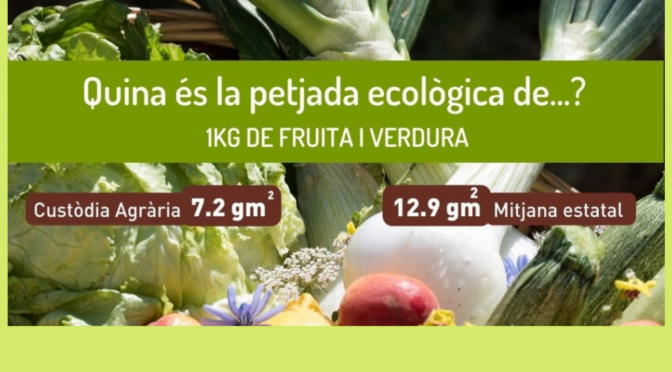Views: 254
Fruit and vegetables produced on the Land Stewardship Farms have an ecological footprint of 66% less than the average of farms at state level. This fact is important because we all eat several times a day. Food is one of the principal activities taking up land at a global level. It is also a major emitter of greenhouse gases.
What is certain is that in food, like in many other things, not everything is comparable. Intensive farming with its use of agricultural chemicals such as synthetic fertilisers, pesticides, herbicides, medications for cattle etc., cannot be compared with the management of the landscape, biodiversity and the soil of a Land Stewardship farm.
To be able to measure the difference, we have calculated the ecological footprint of some of the products of these farms based on methodology applied internationally. The Global Footprint Network is the organisation that produces these reports. The results show a much smaller impact than that made by normal production. This signifies that, if improvements can continue to be incorporated, we could come to production with nearly no footprint, or even with a positive balance in some situations.
The ecological footprint measures the human demand on natural capital (the Earth’s resources). We use this to calculate the quantity of natural resources of the planet that are needed to produce a good or a service – in this case, a kilo of fruit or vegetables – make it available to consumers and manage the resulting waste or impact.
To make this calculation, production factors such as the consumption of fuels and electricity are taken into account, as well as the use of fertilizers, the area of land occupied, or the labour necessary in the process. In the case of this study, the reduction of the ecological footprint of 66% can be broken down into two parts.
The consumption of resources for the production of one kilo of these foods is 44% less than that for conventional farms. This is principally due to the reduction in the use of agricultural chemicals. Talking in terms of an ecological footprint, what is reduced is the natural land necessary to capture the emitted carbon in the production of the fertilisers, pesticides and herbicides that are used so frequently on certain types of farms. In addition, the use of fuels is reduced (and the associated emissions) for the transport of the final product, since the produce is mainly for local consumption: in general within a radius of less than 10 kms from the production site.
Additionally, the ecological footprint of Land Stewardship Scheme products is further reduced when we take into account the wooded areas included on a farm. Considering this variable the footprint is finally reduced by up to 66%. We have called it the “Land Stewardship factor”. Much of the land in the Land Stewardship Scheme programme would not be considered by conventional agriculture as optimal for production. The farms make the most of the mosaic landscape, which combines cultivated land with areas of wild vegetation, for agricultural production.
These natural spaces are preserved within the framework of the sustainability programme carried out by the farms and increase the “biocapacity” of the land. Basically, they act as sinks for the atmospheric carbon that we are liberating from so many of our activities, as well as being reservoirs of biodiversity.
Fruit and vegetables, as well as legumes and other products of vegetable origin, deserve special attention in Menorca. Do we need to increase the production of these foods and how do we do this sustainably? At state level, enough is produced for internal consumption and for the large export of fruit and vegetables, whereas in Menorca local production covers only 6.5% of its fruit consumption and 10% of vegetable consumption.
It is important to consume products from local farms and support, especially, those committed to production methods that benefit nature and preserve the landscape. In this catalogue you can see the farms that are signed up to the Land Stewardship Scheme that sell direct to the public.
If you would like to see the global vision of the Land Stewardship Scheme, the following video.

